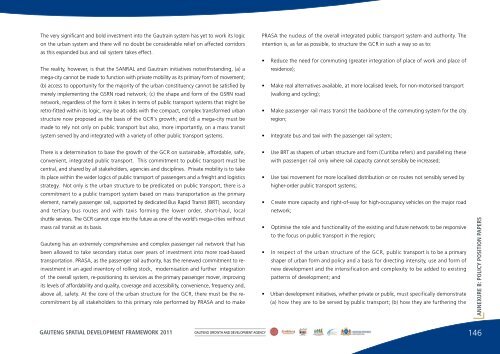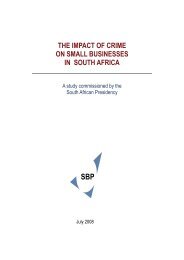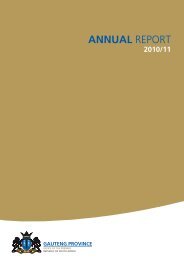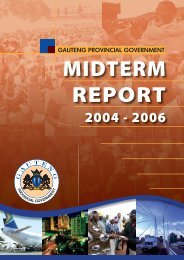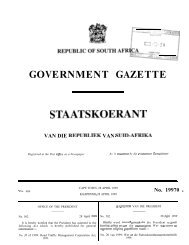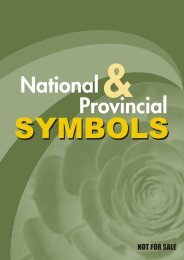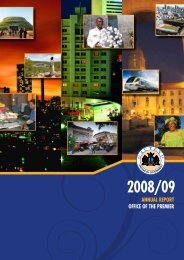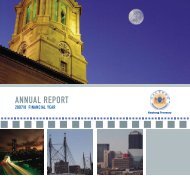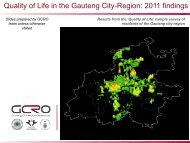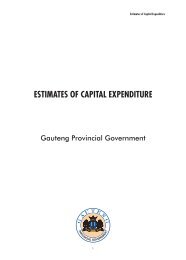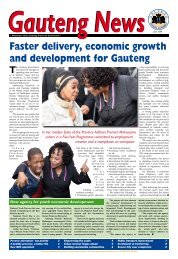THE PRINCIPLES GOVERNING THE TRANSPORT PROGRAMMEFOR THE GCRANNEXURE B: POLICY POSITION PAPERS<strong>Gauteng</strong> Province, <strong>the</strong> smallest province in respect of area, cannot be seen as an island.It is <strong>the</strong> powerhouse of South Africa. It is also <strong>the</strong> confluence of several major transportcorridors linking <strong>the</strong> nor<strong>the</strong>rn SADC countries with sou<strong>the</strong>rn harbours (NI, R21, N3) as wellas <strong>the</strong> east-west corridors between Maputo and Walvis Bay in terms of freight. It is <strong>the</strong>reforecrucial that economic growth and <strong>development</strong> be sustained by transport, as an indisputablecontributor to GDP. The same goes for linkages with neighbouring provinces' economicgrowth points (e.g. Rustenburg, Brits, Ekandustria, Sasolburg, Potchefstroom). Thesecorridors will remain important and need to be catered for in <strong>the</strong> GSDF without compromisingor diluting <strong>the</strong> densification of <strong>development</strong> in <strong>the</strong> GCR.Road construction, at a provincial level, has dominated infrastructural investment in <strong>Gauteng</strong>for <strong>the</strong> past 40 years and has fundamentally shaped an urban system characterised by lowintensitysprawl and a reliance on private mobility. Although incomplete in its implementation,it continues to be one of <strong>the</strong> most influential public policies at work in <strong>the</strong> GCR.IN OPTIMISING NOTHING, WE OPTIMISE EVERYTHINGFor all <strong>the</strong> talk of integrated planning, It is so that traffic, transportation, environmental,economic, <strong>spatial</strong> and land-use planning typically occur in a vacuum from each o<strong>the</strong>rand each planning discipline tends to optimise its own objectives.Optimising any one aspect of <strong>the</strong> urban system perforce compromises something else, andinevitably <strong>the</strong> result is compromised levels of urbanism, <strong>the</strong> very essence of what is requiredto engender <strong>the</strong> growth of urban economies and make cities livable places for <strong>the</strong> vastpopulation we plan for.To date, <strong>the</strong> <strong>the</strong>n PWV road network (now <strong>the</strong> <strong>Gauteng</strong> Strategic Road Network or GSRN)has formed <strong>the</strong> principal structuring element of all city region planning. This is highlightedfor critical enquiry.Roads are a fundamental shaper of urban form and structure, and <strong>the</strong> way in which <strong>the</strong>yare used in building <strong>the</strong> city region's future has to be assessed with care. Similarly, <strong>the</strong> factthat <strong>the</strong>y may detract from focusing on a mass-transit based approach to city-building needsto be evaluated in a determination on <strong>the</strong> role <strong>the</strong> GSRN should continue to play in <strong>the</strong>GSDF.Originally conceived in <strong>the</strong> 1970s as <strong>the</strong> PWV Road Network, <strong>the</strong> GSRN has been, andcontinues to be one of <strong>the</strong> fundamental shapers of urban <strong>development</strong> (<strong>the</strong> GSRN is currentlyunder review). Traffic and transport policy developed in <strong>the</strong> 1970s and 1980s, anticipated,if anything, smaller cities ra<strong>the</strong>r than <strong>the</strong> mega-cities of <strong>the</strong> future, <strong>the</strong> future that is nowupon <strong>the</strong> GCR. Whereas <strong>the</strong> GCR has a population at present of 10.5 million and is projectedto grow to roughly 28 million over <strong>the</strong> next 30 to 40 years, <strong>the</strong> planning scenario prevailingduring <strong>the</strong> 1970s and 1980s could not have anticipated an urban region of this extent.Clearly, <strong>the</strong> entire basis of that planning needs to be reviewed. The question now arises asto whe<strong>the</strong>r <strong>the</strong> system as planned can be adapted to suit prevailing realities and achieve<strong>the</strong> transforming intentions of <strong>the</strong> GSDF.The roads infrastructure of <strong>the</strong> GCR, most notably <strong>the</strong> freeway and urban arterial systems,are under severe pressure. The public transport systems are both inadequate and unintegrated.In respect of traffic, one might question whe<strong>the</strong>r <strong>the</strong> rapid expansion of <strong>the</strong>urban system over <strong>the</strong> past 15 years has simply outstripped <strong>the</strong> rate at which infrastructuralinvestment in roads can be made. This stresses <strong>the</strong> need to focus on public transport tocater for <strong>the</strong> travel demand. The present SANRAL upgrading programme can in fact bringonly short-term relief given <strong>the</strong> scale and nature of <strong>the</strong> growing of mega-cities in developingcountries. The current work by SANRAL is part of a sustainable long-term plan for <strong>the</strong>upgrading of <strong>Gauteng</strong>'s freeways as has been approved by <strong>the</strong> national and provincialcabinets. The challenge however will be to ensure by means of travel demand measures(High Occupancy Vehicle lanes and Public Transport lanes) that public transport is supportedas well as <strong>the</strong> future rollout support for <strong>the</strong> GCR mega-city concept.145 GAUTENG SPATIAL DEVELOPMENT FRAMEWORK 2011 GAUTENG GROWTH AND DEVELOPMENT AGENCY
The very significant and bold investment into <strong>the</strong> Gautrain system has yet to work its logicon <strong>the</strong> urban system and <strong>the</strong>re will no doubt be considerable relief on affected corridorsas this expanded bus and rail system takes effect.The reality, however, is that <strong>the</strong> SANRAL and Gautrain initiatives notwithstanding, (a) amega-city cannot be made to function with private mobility as its primary form of movement;(b) access to opportunity for <strong>the</strong> majority of <strong>the</strong> urban constituency cannot be satisfied bymerely implementing <strong>the</strong> GSRN road network; (c) <strong>the</strong> shape and form of <strong>the</strong> GSRN roadnetwork, regardless of <strong>the</strong> form it takes in terms of public transport systems that might beretro-fitted within its logic, may be at odds with <strong>the</strong> compact, complex transformed urbanstructure now proposed as <strong>the</strong> basis of <strong>the</strong> GCR's growth; and (d) a mega-city must bemade to rely not only on public transport but also, more importantly, on a mass transitsystem served by and integrated with a variety of o<strong>the</strong>r public transport systems.PRASA <strong>the</strong> nucleus of <strong>the</strong> overall integrated public transport system and authority. Theintention is, as far as possible, to structure <strong>the</strong> GCR in such a way so as to:• Reduce <strong>the</strong> need for commuting (greater integration of place of work and place ofresidence);• Make real alternatives available, at more localised levels, for non-motorised transport(walking and cycling);• Make passenger rail mass transit <strong>the</strong> backbone of <strong>the</strong> commuting system for <strong>the</strong> cityregion;• Integrate bus and taxi with <strong>the</strong> passenger rail system;There is a determination to base <strong>the</strong> growth of <strong>the</strong> GCR on sustainable, affordable, safe,convenient, integrated public transport. This commitment to public transport must becentral, and shared by all stakeholders, agencies and disciplines. Private mobility is to takeits place within <strong>the</strong> wider logics of public transport of passengers and a freight and logisticsstrategy. Not only is <strong>the</strong> urban structure to be predicated on public transport, <strong>the</strong>re is acommitment to a public transport system based on mass transportation as <strong>the</strong> primaryelement, namely passenger rail, supported by dedicated Bus Rapid Transit (BRT), secondaryand tertiary bus routes and with taxis forming <strong>the</strong> lower order, short-haul, localshuttle services. The GCR cannot cope into <strong>the</strong> future as one of <strong>the</strong> world's mega-cities withoutmass rail transit as its basis.<strong>Gauteng</strong> has an extremely comprehensive and complex passenger rail network that hasbeen allowed to take secondary status over years of investment into more road-basedtransportation. PRASA, as <strong>the</strong> passenger rail authority, has <strong>the</strong> renewed commitment to reinvestmentin an aged inventory of rolling stock, modernisation and fur<strong>the</strong>r integrationof <strong>the</strong> overall system, re-positioning its services as <strong>the</strong> primary passenger mover, improvingits levels of affordability and quality, coverage and accessibility, convenience, frequency and,above all, safety. At <strong>the</strong> core of <strong>the</strong> urban structure for <strong>the</strong> GCR, <strong>the</strong>re must be <strong>the</strong> recommitmentby all stakeholders to this primary role performed by PRASA and to make• Use BRT as shapers of urban structure and form (Curitiba refers) and paralleling <strong>the</strong>sewith passenger rail only where rail capacity cannot sensibly be increased;• Use taxi movement for more localised distribution or on routes not sensibly served byhigher-order public transport systems;• Create more capacity and right-of-way for high-occupancy vehicles on <strong>the</strong> major roadnetwork;• Optimise <strong>the</strong> role and functionality of <strong>the</strong> existing and future network to be responsiveto <strong>the</strong> focus on public transport in <strong>the</strong> region;• In respect of <strong>the</strong> urban structure of <strong>the</strong> GCR, public transport is to be a primaryshaper of urban form and policy and a basis for directing intensity, use and form ofnew <strong>development</strong> and <strong>the</strong> intensification and complexity to be added to existingpatterns of <strong>development</strong>; and• Urban <strong>development</strong> initiatives, whe<strong>the</strong>r private or public, must specifically demonstrate(a) how <strong>the</strong>y are to be served by public transport; (b) how <strong>the</strong>y are fur<strong>the</strong>ring <strong>the</strong>ANNEXURE B: POLICY POSITION PAPERSGAUTENG SPATIAL DEVELOPMENT FRAMEWORK 2011GAUTENG GROWTH AND DEVELOPMENT AGENCY146
- Page 1:
THE GAUTENG SPATIAL DEVELOPMENT FRA
- Page 4 and 5:
TABLE OF CONTENTSSECTION 1: INTRODU
- Page 6 and 7:
Table A.2-iv: Summary - Typical per
- Page 8 and 9:
FIGURESSECTION 1: INTRODUCTIONFigur
- Page 10 and 11:
Figure A.2.4: Modelling key compone
- Page 12 and 13:
FOREWORD
- Page 14 and 15:
SECTION1:Introduction
- Page 16 and 17:
development framework around which
- Page 18 and 19:
SECTION 1: INTRODUCTIONcadastral in
- Page 20 and 21:
Not only does it seem necessary to
- Page 22 and 23:
SECTION 2: THE GSDF AS A CONCEPTA S
- Page 24 and 25:
disasters, shortages and changes in
- Page 26 and 27:
are to promote sustainability, equi
- Page 28 and 29:
It is legislated that metropolitan
- Page 30 and 31:
Similarly, there must be a consiste
- Page 32 and 33:
The corridors reflected in the figu
- Page 34 and 35:
Similarly, in the United Kingdom, i
- Page 36 and 37:
• urban compactness, also noted i
- Page 38 and 39:
With Johannesburg as the city syste
- Page 40 and 41:
Making sense of, and integrating, t
- Page 42 and 43:
Based on this figure, it is suggest
- Page 44 and 45:
On this basis, there is no reason w
- Page 46 and 47:
SECTION 2: THE GSDF AS A CONCEPTPRI
- Page 48 and 49:
SECTION 2: THE GSDF AS A CONCEPTPRI
- Page 50 and 51:
SECTION3:The modelling elements of
- Page 52 and 53:
value that goes with this can be de
- Page 54 and 55:
THE MODELLING THAT UNDERPINS THE GS
- Page 56 and 57:
MODEL 2: THE MORPHOLOGICAL MODELaro
- Page 58 and 59:
with lower levels of accessibility.
- Page 60 and 61:
MODEL 5: THE VIRTUAL MODEL ROOMSECT
- Page 62 and 63:
URBAN MANAGEMENT AND SPATIAL DEVELO
- Page 64 and 65:
making processes around these (for
- Page 66 and 67:
The intricacies of the urban struct
- Page 68 and 69:
SECTION 4: OUTCOMES OF APPLICATION:
- Page 70 and 71:
STEP SIX: URBAN DEVELOPMENT, MANAGE
- Page 72 and 73:
THE COMPOSITE SPATIAL STRUCTUREThe
- Page 74 and 75:
SECTION 4: OUTCOMES OF APPLICATION:
- Page 76 and 77:
FRAMEWORK FOR THE IMPLEMENTATION OF
- Page 78 and 79:
SECTION 5: FRAMEWORK FOR THE IMPLEM
- Page 80 and 81:
TRANSPORTATIONThe principles of urb
- Page 82 and 83:
URBAN STRUCTURING INITIATIVESSECTIO
- Page 84 and 85:
SECTION 5: FRAMEWORK FOR THE IMPLEM
- Page 86 and 87:
It is not enough, however, to simpl
- Page 88 and 89:
APPENDIXA.1: The urban profile mode
- Page 90 and 91:
ANNEXURE A: THE 5 GIS-BASED MODELSF
- Page 92 and 93:
THE IDENTIFICATION OF MORPHOLOGICAL
- Page 94 and 95:
ANNEXURE A: THE 5 GIS-BASED MODELSU
- Page 96 and 97:
DEFINING THE MORPHOLOGICAL COMPONEN
- Page 98 and 99:
• Activity Spines, with a hierarc
- Page 100 and 101:
ANNEXURE A: THE 5 GIS-BASED MODELSN
- Page 102 and 103:
comprises specialised trade, such a
- Page 104 and 105:
• Development Intensity: Land are
- Page 106 and 107:
THE REGIONAL NODEDevelopment Yield:
- Page 108 and 109: THE TYPICAL PERFORMANCE DIMENSION O
- Page 110 and 111: TYPICAL DEVELOPMENT PARAMETERS: URB
- Page 112 and 113: ANNEXURE A: THE 5 GIS-BASED MODELSF
- Page 114 and 115: ANNEXURE A: THE 5 GIS-BASED MODELSF
- Page 116 and 117: Figures A.2.13-15 show the same are
- Page 118 and 119: ANNEXURE A: THE 5 GIS-BASED MODELSF
- Page 120 and 121: THE CONNECTIVITY MODELANNEXURE A: T
- Page 122 and 123: CONNECTIVITY MODEL 2This iteration
- Page 124 and 125: CONNECTIVITY MODEL 4The fourth iter
- Page 126 and 127: CONNECTIVITY MODEL 6The final itera
- Page 128 and 129: THE BID-RENT MODELThe Bid-Rent Mode
- Page 130 and 131: TOPOGRAPHIC SUITABILITYThe Topograp
- Page 132 and 133: THE SPATIAL POLICY SUPPORT INDEXThe
- Page 134 and 135: SURFACE CONSTRAINTSThe Surface Cons
- Page 136 and 137: APPENDIXA.5Model 5 - the virtualmod
- Page 138 and 139: TSHWANE STATIONS123Existing conditi
- Page 140 and 141: APPENDIXB.1: Restrictingurban spraw
- Page 142 and 143: urban edge, many of the municipal S
- Page 144 and 145: ANNEXURE B: POLICY POSITION PAPERSF
- Page 146 and 147: APPENDIXB.2: A densification policy
- Page 148 and 149: The model that is to guide both res
- Page 150 and 151: APPENDIXB.3: Harmonisinghousingprov
- Page 152 and 153: housing and mixed-uses can be reali
- Page 154 and 155: ANNEXURE B: POLICY POSITION PAPERSF
- Page 156 and 157: ANNEXURE B: POLICY POSITION PAPERSF
- Page 160 and 161: ANNEXURE B: POLICY POSITION PAPERSi
- Page 162 and 163: Possible outer extentsof urban deve
- Page 164 and 165: APPENDIXB.5: Thecase principles ofs
- Page 166 and 167: sustainable and efficient. A long-t
- Page 168 and 169: ANNEXURE B: POLICY POSITION PAPERSB
- Page 170 and 171: APPENDIXC.1: Thefreight and logisti
- Page 172 and 173: overall platform on which more focu
- Page 174 and 175: A further south-eastern regional hu
- Page 176 and 177: ANNEXURE C: POLICY PERSPECTIVESFigu
- Page 178 and 179: APPENDIXC.2: A perspective guidingt
- Page 180 and 181: anges of hills or mountains, whethe
- Page 182 and 183: APPENDIXC.3: Preservationof landhav
- Page 184 and 185: ANNEXURE C: POLICY PERSPECTIVESFigu
- Page 186 and 187: URBAN CONSOLIDATION ZONESThe physic
- Page 188 and 189: APPENDIXC.5: Indicativepatterns ofe
- Page 190 and 191: ANNEXURE C: POLICY PERSPECTIVESFigu
- Page 192 and 193: ANNEXURE C: POLICY PERSPECTIVESFigu
- Page 194 and 195: APPENDIXC.6: Integrationof the rura
- Page 196 and 197: opportunity that goes with being ab
- Page 198 and 199: ANNEXURED: The package of plans
- Page 200 and 201: In order to achieve spatial integri
- Page 202 and 203: LEVEL ESSENTIAL FOCUS AND SCOPE SCA
- Page 204 and 205: LEVEL ESSENTIAL FOCUS AND SCOPE SCA
- Page 206 and 207: ANNEXUREE: Glossary of terms
- Page 208 and 209:
Brownfield Land and SitesPreviously
- Page 210 and 211:
ANNEXURE E: GLOSSARY OF TERMSTown -
- Page 212 and 213:
Development ManagementThe process w
- Page 214 and 215:
Geographic Spread Programme (DTI)Th
- Page 216 and 217:
ANNEXURE E: GLOSSARY OF TERMSIntegr
- Page 218 and 219:
ANNEXURE E: GLOSSARY OF TERMSSpatia
- Page 220 and 221:
ANNEXURE E: GLOSSARY OF TERMSUrban
- Page 222:
ANNEXURE E: GLOSSARY OF TERMS• Ur


